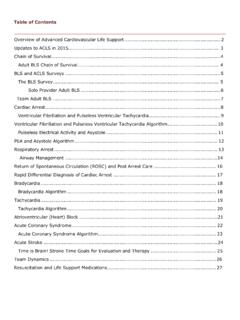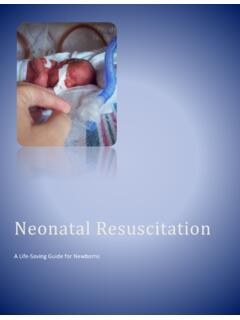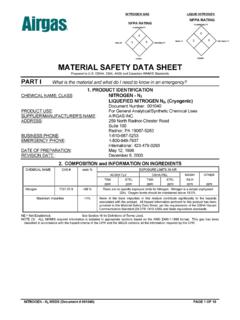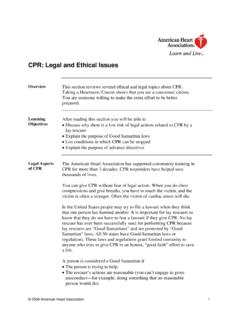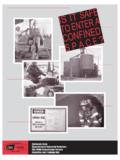Transcription of Child and Infant CPR - National CPR Association
1 Child and Infant CPR. FOLLOWS 2010 ECC/ILCOR GUIDELINES. Updated with 2015 Guidelines Welcome! We're excited that you've decided to take Child and Infant CPR, and that you've chosen us to direct your learning experience. You never know when you may be called upon to perform CPR on a Child or Infant . All parents, grandparents, babysitters, older siblings, daycare workers, teachers and anyone else who lives or works with children should learn how to perform CPR when disaster strikes. CPR can save a Child 's life by providing the brain, heart and other organs with life-giving oxygen in the event of respiratory and/or cardiac arrest. Drowning, poisoning, accidents, smoke inhalation and SIDS are only a few of the emergencies that could result in death if not treated quickly. In this course, you will learn: The Pediatric Chain of Survival and your place within the chain How to provide high quality chest compressions for children and infants How to initiate early use of an AED (automated external defibrillator).
2 How to provide rescue breathing for pediatric victims of respiratory arrest How to provide CPR to children and infants when there are 2 rescuers How to assist Child and Infant victims of choking Let's get started! The Five Fears Many bystanders are reluctant to perform CPR. There are many reasons why bystanders are reluctant to get involved. Let's take a look at some of these reasons so that you can understand why they have no real basis of support. Fear of Disease: Use universal precautions when the possibility exists of coming into contact with bodily fluids. Use gloves, mask, and/or a gown when you have them available. The benefit of initiating lifesaving resuscitation in a Child in cardiopulmonary arrest greatly outweighs the risk for secondary infection in the rescuer or the Child . Nevertheless, use of simple infection-control measures during CPR.
3 And CPR training can reduce a very low level of risk even further (Mejicano & Maki, 1998). This fear is not as prevalent when dealing with infants and children, who are less likely to be harboring serious bloodborne pathogens. Fear of Lawsuits: These laws state that a person acting in good faith who is rendering reasonable first aid will not be held accountable for damages to the person to whom the aid is rendered, unless gross and willful misconduct are involved. Good Samaritan laws may differ for from state to state. Implied consent means that there is an assumption that if an unconscious person were able to request care, they would do so (or their parent/guardian would do so on their behalf). Fear of Uncertainty: People sometimes fear that they won't remember what to do. Remembering the correct number of compressions or the number of compressions to ventilations is not as important as the willingness to respond and to push hard and fast.
4 Hands-only CPR is designed to provide simple life support. Remember, anything you do is better than doing nothing at all! Fear of Harming the Victim: A victim in need or clinically dead can only be helped by your intervention efforts. You can't hurt someone who is dead, and any injuries you may unknowingly cause (such as injured ribs) can be dealt with in a surviving victim of respiratory or cardiac arrest. Children and infants are surprisingly resilient! Fear of Injury to Self: As you will learn, scene safety is of utmost importance, and checking the scene for safety should be your first action when you come across an unconscious victim, even if the victim is a Child . If the scene is not safe for you to enter, you must not enter. This will only result in more victims. Under no circumstances should you risk becoming a victim. Instead, you should call for help (activate EMS).
5 As a rescuer, you must always check to ensure the scene is safe before rendering assistance to any victim! BASIC ANATOMY AND PHYSIOLOGY. Before you learn how to perform CPR, it's important to understand how the heart, lungs, brain and cells perform. Here is a brief review of these systems. THE HEART. The heart consists of four chambers, the right and left atria (singular: atrium) and the right and left ventricles. The atria are located above the ventricles, as can be seen in the above diagram. The heart is a muscular organ supplied by the coronary arteries. It is located below your breastbone (sternum). In children and infants, their hearts are about the size of their fists. The heart pumps blood that has been deoxygenated by supplying the body's tissues into the lungs, and when that blood has been oxygenated again in the lungs, it exits the lungs to the left side of the heart, where it is pumped out into the tissues once again to provide live-giving oxygen.
6 Your body has about 5 liters of blood, which circulate through this system approximately 3 times per minute. A Child will have less circulating blood volume, depending on their age- a Child of 80 pounds will have approximately half the circulating blood volume of an average-sized adult. Infants will have far less. This is why blood loss can be devastating to a Child . What is known as the cardiovascular system is composed of the heart, arteries, capillaries, and veins. THE LUNGS. Your lungs are spongy, air-filled sacs, with one lung located on either side of the chest. The trachea, which is sometimes called the windpipe, conducts air down into the lungs through the bronchi, which are smaller tubular branches. The bronchi then divide into smaller and smaller tubules called bronchioles. Air is exchanged in the alveoli, which are tiny sacs that allow oxygen and carbon dioxide to move between the lungs and the bloodstream via tiny capillaries.
7 Your lungs take in oxygen to supply your body's organs and tissues. They release carbon dioxide, a waste product, into the atmosphere when you exhale. Room air at regular atmospheric pressure contains 21% oxygen. Our bodies utilize approximately 4-6%. of that oxygen and release about 17% back into the atmosphere, along with carbon dioxide, when we exhale. Children have higher respiratory rates than adults. Higher respirator rates lead to proportionately higher minute volumes. As a result, children may be more susceptible to agents absorbed through the pulmonary route than adults with the same exposure. Children may also respond more rapidly to such agents. Because children's airways are much smaller, and they have a shorter trachea and a relatively larger tongue size than adults, they are more susceptible to breathing and airway problems. Respiratory arrest is a common cause of cardiac arrest in children.
8 THE BRAIN. Your brain needs a constant supply of oxygen. Without oxygen, brain cells begin to die in 4 to 6 minutes. On average, the adult brain weighs three pounds, and uses 20% of the body's oxygen. In children, the brain reaches 95% of adult size by the age of seven. The medulla is located in the brain stem and controls automatic bodily functions, including consciousness and respiratory and cardiovascular function. THE BODY'S CELLS. All of the body's tissues are made up of cells. All cells require oxygen to carry out their normal functions. They also require nutrients. Oxygen deprivation, or hypoxia, will cause cells to die within a few short minutes. The body's cells use oxygen and produce carbon dioxide as a waste product. Carbon dioxide must be eliminated through the lungs through ventilation. Red blood cells transport oxygen throughout the body.
9 Children have a smaller circulating blood volume; therefore, any loss of blood can affect them profoundly. The Pediatric Chain of Survival The pediatric chain of survival can be thought of as a sequence of events that must occur in order to restore health in a Child or Infant victim of sudden cardiac arrest. Because children are more prone to respiratory arrest and shock, it is essential to recognize and prevent airway and breathing problems before they occur to prevent cardiac arrest and to ensure survival and full recovery. For this reason, the most important link in the pediatric chain of survival is prevention. Unintentional injuries are the number one cause of death in children. Children's lives can be saved by focusing on prevention of emergencies. Knowing CPR is important, but even more important is ensuring that CPR is never needed in the first place!
10 Therefore, the Pediatric Chain of Survival includes: Prevention of respiratory/cardiac arrest Early high-quality CPR. Activation of the Emergency Response System Early advanced life support Comprehensive post- cardiac arrest care THE TEAM APPROACH. In many situations, there may be only one rescuer who will carry out the normal sequence of assessments and actions. However, in many situations, there is often more than one rescuer trained and willing to help. This is when a team approach can be used. The first rescuer should take the role of team leader and delegate tasks. One rescuer can provide compressions, one can prepare to give breaths with a face mask or mouth-to-mouth, and one can prepare the AED. By working together, the most efficient care can be given to the patient. Of course, if you are the only rescuer present, you will have to do all of these things.

